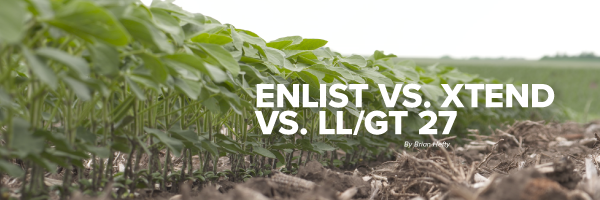
Perhaps the biggest question you are still asking for your farm this season is, “Which soybean trait should I go with?” Here’s a quick analysis on how we see it.
WHATEVER YOU DO, GO 100%.
As a general rule, we tell you not to put all your eggs in one basket, and never to try something new on 100% of your acres. However, our biggest concern with using some of each seed trait is spraying the wrong product in the wrong field. Last year, the guys on our farm asked me to please, please, please not have multiple traits on the farm. Their fear was the same as mine. A dead field is no fun, especially when you’ve done it to yourself.
If you’ve never planted Enlist, Xtend, or LL/GT 27, have no fear. Each of these 3 traits is outstanding, and each has fantastic yield potential. Our recommendation is always the same, whether you’ve planted the trait before or not.
XTEND is proven, has lots of great-yielding varieties, and allows you to spray the new formulations of dicamba (Xtendimax, Fexapan, and Engenia) pre-emerge or over the top. Xtend seed prices are down quite a bit from last year, as well. The number one reason why many farmers tell me they don’t want to plant Xtend is because they are worried about spray drift.

Smoke moving via an air inversion. One method of reducing dicamba volatilization is to avoid spraying in conditions that cause air inversions, which can lead to off-target movement.
Just so you know, dicamba drift complaints plummeted in 2019. Certainly, soybean acres were down, but the bigger factor was applicators learned how best to apply the product, clean it out of spray tanks, etc. Our advice, if you have sensitive crops nearby, is to spray when the wind is blowing away from the sensitive crops during spraying and for 48 hours afterwards. That way even if some minor volatility was to occur, it won’t affect the neighboring crop. Perhaps the best part about having dicamba as a weed control option in soybeans is to maximize burndown. Dicamba is outstanding on most early-season broadleaf weeds, and if you are in no-till or strip-till you will love it! Our only word of caution is to spray when the weather is warm (70+ degrees) for very best results with your burndown. While the other 2 trait options are appealing, it’s hard for many farmers to step away from the proven high yields they’ve been getting with Xtend.
ENLIST E3 offers you the ability to spray Liberty or Roundup, along with 2,4-D (Enlist One). If you don’t want to spray the growth regulator (2,4-D) late in the season, you can use Liberty to control Roundup-resistant weeds. The price of Enlist beans went down almost $10 per unit from last year, and we wouldn’t be surprised to see it come down even more in the future as they try to steal market share away from Xtend, which is now the most popular soybean trait in the U.S. While you may have heard that “Enlist doesn’t yield”, this is utter nonsense. We have seen some outstanding yields in many of the Enlist lines, and in our research, Enlist won trials about as often as Xtend. Both are great and far superior to the old traits and conventional soybeans. Our biggest concern for you with Enlist is not 2,4-D drift, as Enlist One has shown almost no volatility. Our biggest worry is that you pick the right varieties if you have bad IDC (iron deficiency chlorosis). There are good IDC Enlist beans, but if you’ve never planted any, you may not know which ones fit on high pH ground and which ones don’t, so make sure you work closely with your seed advisor. If you pick the right numbers, you will absolutely love Enlist beans
LL/GT 27 has gotten very little publicity, but it may be exactly what you need. Due to late applications of HPPD herbicides in 2019 and some of the very high rates we’ve seen used, expect carryover to be an issue here and there in fields throughout the U.S. If you have any fear, plant LL/GT 27. The “27” means tolerance to pre-emerge (or carryover) HPPD herbicides. The HPPD family includes Laudis, Callisto, Armezon, and Impact, but there are many premixes with heavy doses of HPPD, as well, including Acuron, Acuron Flexi, Halex GT, Resicore, and others. While there are currently no pre-emerge HPPD herbicides labeled in front of LL/GT 27 beans, we are seeing good tolerance to HPPD carryover. Additionally, you can spray Roundup and/or Liberty over the top of these beans. There is currently not a robust selection of LL/GT 27 soybeans available, but there are certainly some high-yielders. Since HPPDs are cheap and, in our opinion, getting over-used in many cases, we expect LL/GT 27 acres to grow in the future.
